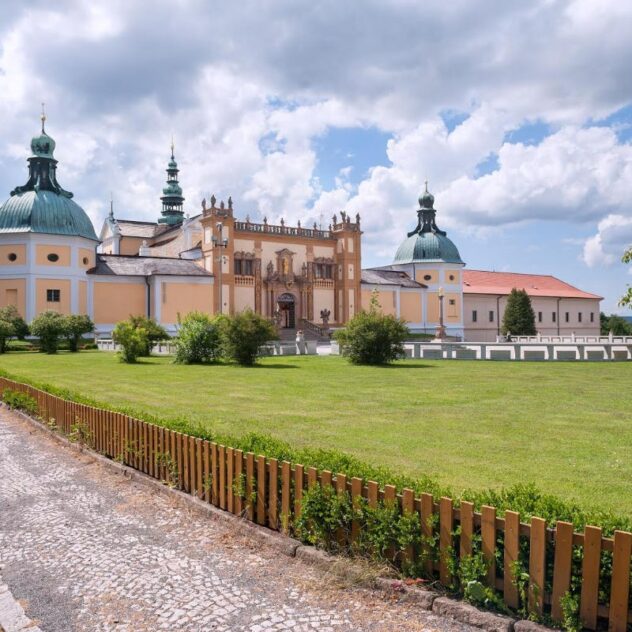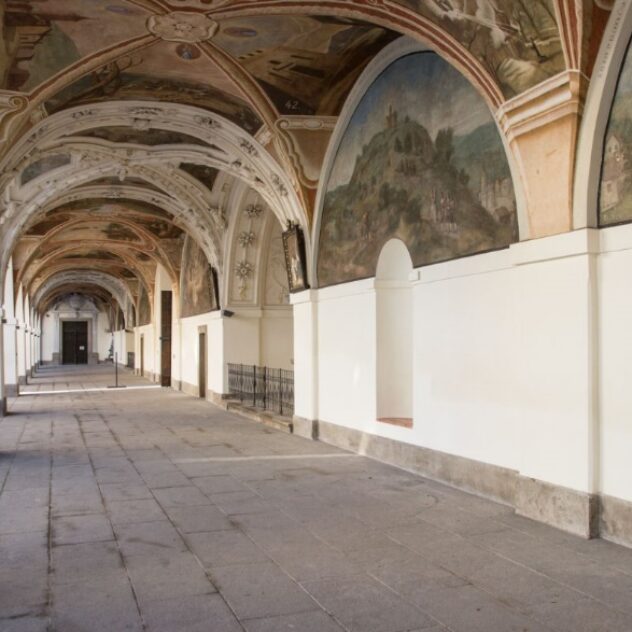Svatá Hora near Příbram
Information about the pilgrimage site
Svatá hora is one of the typical Baroque pilgrimage sites that enjoyed centuries of popularity from Baroque times until the advent of communism in Czechoslovakia. Originally it was just a chapel, which according to legend was founded in the 13th century by a knight of the Malovec family as a thank you to the Virgin Mary for answering his prayers when she protected him from pursuing robbers. The earliest known plan of Svatá Hora, dating from about 1658, shows a central sanctuary, but the unsophisticated nature of the building does not exclude the possibility that it was built by a hermit himself, without a demanding architectural plan. Next to the chapel stood a hermitage, where the Příbram community installed hermits in the 16th and the first half of the 17th century. The most famous of the pilgrims was Jan Procházka, a burgher from Nymburk. He went blind in 1619 and lived as a beggar in Prague until 1632. At that time he had a dream to go to the Holy Mountain and worship the Virgin Mary there. After repeated urging, Procházka obeyed the dream and after three days on the Holy Mountain his sight returned. Thanks to Procházka, the Holy Mountain gained fame, until then it was an unknown place. The news of Procházka’s miraculous recovery spread quickly and reached Vienna. In 1634, Emperor Ferdinand II and his son, later Ferdinand III, visited Svatá Hora. In the same year, the hermit Procházka dug a well, later called the Marian Well.
Pilgrims to Svatá Hora were increasing and the dean of Příbram could not meet them due to the lack of clergy during the Thirty Years’ War. Therefore, the place was offered to the Jesuit order for administration, who accepted it in 1647. They connected Svatá Hora by the Stations of the Cross with Březnice, where they had a dormitory.
The Jesuits took care of the pilgrimage site and the pilgrims. They organized pilgrimages, beautified the place and created a generous pilgrimage area. In 1658, the architect Carlo Lurago drew up the first project for the generous construction of the pilgrimage site according to the conceptual design of the Jesuit P. Benjamin Schleyer.
Since then, the Svatohorský complex has become one of the largest and most important early Baroque buildings in the country. In addition to the nobility, many of whose members were representatives of the Jesuit Order, towns such as Prague, Pilsen, Mníšek and Březnice participated in the construction and decoration. However, the largest number of donations came from the now unknown pilgrims.
Pilgrims travel to Svatá Hora mainly to venerate the statue of the Virgin Mary, which was not in the original chapel. It is shrouded in legend that it was created by the hand of the first Archbishop of Prague, Arnost of Pardubice. Historians have only confirmed that it is a Gothic carving of Czech provenance. Like the Prague Jesuit, it is also dressed and decorated, since 1732 the Virgin Mary and the Baby Jesus have gold crowns made by the Prague goldsmith Jan Ferdinand Schachtel.
In 1773 the Jesuit order was abolished and the administration was taken over by secular administrators. In 1861, the Redemptorists (Congregation of the Most Holy Redeemer) took over the administration of Svatá Hora and took care of the pilgrimage site until 1950. In 1905, Pope Pius X granted the Redemptorists’ request and elevated the Holy Mountain to the status of a “minor basilica”.
The whole area of the pilgrimage site required constant care and several times even major repairs or reconstruction over the centuries. In 1978, a fire broke out at Svatá Hora, causing one of the biggest damages to the site. In 1982 everything was repaired except for the paintings in part of the ambulatory.
Since 1990, the spiritual administration of the Holy Mountain has again been entrusted to the priests of the Congregation of the Most Holy Redeemer, the Redemptorists. The first administrator and rector of the monastery was P. Josef Břicháček. At the same time, Svatá Hora became the seat of the provincial of the Redemptorists. The renovation of the premises continues, thanks to the care of the civic association Matica Svatohorská. In 2015, thanks to a large grant, an overhaul was carried out, which gave Svatá Hora a new look, lecture and exhibition spaces and much more. Since the fall of communism, pilgrims and tourists from all over the world have been visiting Svatá Hora.
Tourist attractions in the vicinity
Rožmitál pod Třemšínem – is a picturesque Central Bohemian town with a historical centre. In the Middle Ages it belonged to the Lords of Rožmital, from whom the famous diplomat and traveller Lev of Rožmital originated. Another important native was Jakub Jan Ryba, who composed the Czech Christmas Mass. More information is on the town’s website. For more information visit https://www.rozmitalptr.cz/volny-cas/turistika/pamatky/ .
Dobříš Chateau – is a baroque building, which again belongs to the Colloredo – Mansfeld family. The castle and the adjacent gardens are open to the public. More information can be found on the castle’s homepage. For more information visit https://www.zamekdobris.cz/
Skalka pilgrimage area – this pilgrimage site is located above the town of Mníšek pod Brdy. It lies on marked hiking trails, the Stations of the Cross are accessible throughout the year, the church and monastery are accessible from April to October. For more information visit https://www.mnisek.cz/pamatky/barokni-areal-skalka/ .
Březnice Castle – this Renaissance gem is the biggest attraction of the town of the same name. From Svatá Hora, pilgrims can walk here along the holy path with 16 crosses built by the Jesuits during their time in both places. More information about the castle can be found on the property’s website. For more information, visit https://www.zamek-breznice.cz/cs .
The Brdy Mountains – Brdy are mountains that were used in the past by the Czechoslovak army as a military training base. It is one of the most popular tourist destinations today, offering a wide range of cultural and natural excursions. For more information visit https://www.brdyapodbrdsko.cz/ .
Other tourist attractions in the area can be found on the website:
Central Bohemia Tourism Centre
https://www.brdyapodbrdsko.cz/
Accommodation
- Accommodation for pilgrims is available directly in the parish’s exorcism house, which is within sight of the Holy Contact details are on the home page of the property: https://svata-hora.cz/farnost/ubytovani/
- Commercial accommodation offers hotels, pensions and campsites in Příbram.
Availability
By car
Svatá Hora is accessible by car, parking is available in Balbínov Street near the pilgrimage steps. Pilgrims have to climb up. Up-to-date information is on the homepage.
By public transport
The site is accessible by bus to the Svatá Hora bus stop. It is accessible by train to Příbram, then you can walk or take a bus. Details of connections can be checked at www.idos.cz
On foot
Several marked hiking trails lead through Svatá Hora. As the name suggests, the terrain is hilly.
On a bicycle
The area of Svatá Hora is very accessible also on bicycles.







